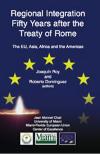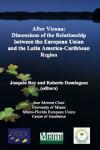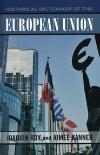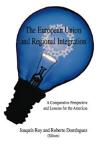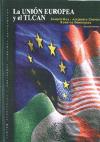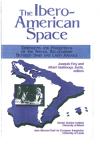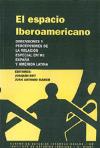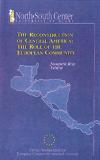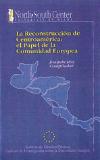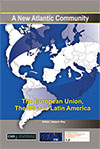 A New Atlantic Community
A New Atlantic Community
Joaquín Roy, 2015.
Download book
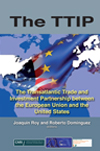 The Transatlantic Trade and Investment Partnership between the European Union and the United States
The Transatlantic Trade and Investment Partnership between the European Union and the United States
Joaquín Roy and Roberto Domínguez (editors), 2014.
Download Book
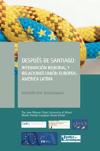
Después de Santiago: Integración Regional Y Relaciones Unión Europea-América Latina
Joaquín Roy (Compilador), 2013.
Download book
The State of the Union(s): The Eurozone Crisis, Comparative Regional Integration and the EU Model
Joaquín Roy (editor), 2012.
Download book
Spain in the European Union: the First Twenty-Five Years (1986-2011)
Joaquín Roy and María Lorca-Susino (editors), 2011.
Download book
España, la Unión Europea y la integración latinoamericana
Joaquín Roy y Roberto Domínguez (comp.) Coral Gables, FL: University of Miami European Union Center/ Jean Monnet Chair, 2010.
Download book
Lisbon Fado: The European Union under Reform
Joaquín Roy and Roberto Domínguez (eds). Miami: European Union Center of Excellence/Jean Monnet Chair, University of Miami, 2009.
Download book
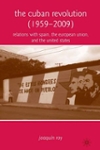 The Cuban Revolution (1959-2009): its relationship with Spain, the European Union and the United States.
The Cuban Revolution (1959-2009): its relationship with Spain, the European Union and the United States.
Joaquín Roy. Palgrave Macmillan, New York, 2009.
Available at University of Miami's Richter Library HERE
The European Union, fifty years after the Treaty of Rome (March 25, 1957): The EU model in the Americas, Asia and Africa.
Joaquín Roy and Roberto Domínguez (eds). Miami: European Union Center of Excellence/Jean Monnet Chair, University of Miami, 2008.
Joaquín Roy (University of Miami), “Reflections on the Treaty of Rome”; Gaspare M. Genna (University of Texas at El Paso), “Power Preponderance, Institutional Homogeneity, and the Likelihood of Regional Integration.”; Markus Thiel (Florida International University), “Cultural identity and regional integration”; Olufemi Babarinde (Thunderbird, The Garvin School of International Management, Glendale, Arizona), “The African Union: finally in the path of the EU?; Astrid Boening (University of Miami) “The Euro-Med partnership and regional integration”; Katjia Webber (Georgia Institute of Technology), “European security integration: lessons for East Asia?; Laura Gómez-Mera (University of Miami), “Obstacles to regional integration in Latin America and the Caribbean”; Roberto Domínguez (Suffolk University, Boston), “NAFTA: will it ever have an EU pro profile?”; Wendy Grenade (University of West Indies, Barbados), “CARICOM: coming of age?”; Aimee Kanner (Florida Atlantic University), "Prospects for New Governance in South America: Insights from Europe"; Marcos Aurelio Guedes de Oliveira (Federal University of Pernambuco, Brazil), “The Origin and Evolution of the South American Community of Nations”
Download book
After Vienna: the EU-Latin America-Caribbean Relationship.
Joaquín Roy and Roberto Domínguez (editors). Miami: European Union Center of Excellence/ Jean Monnet Chair, University of Miami, 2007. 149 p.
Download book
The Euro and the Dollar in a Globalized Economy
Ashgate Publishing: Aldershot, UK, 2007. Joaquín Roy and Pedro Gomis- Porqueras (editors). 235 p.
ISBN 978-0-7546-7153-4 LC HG925.E8676 2007
Available at the University of Miami's Richter Library HERE
Introduction; PART 1: The Euro, this unknown!; Ch. 1: Pedro Gomis-Porqueras: “Introduction to the Dollar and the Euro”; Ch. 2: Joaquín Almunia: “Seven years with the Euro”; Ch. 3: Joaquín Roy: “A financial and politically symbolic tool”; PART 2: The Euro-dollar exchange rate: A puzzling relationship; Ch. 1: Kurt Huebner, “The Euro-Dollar Puzzle”; Ch. 2 : Hans Martens, “Euro-Dollar: A holistic view of the economy.”; PART 3: The international role of the Euro: waiting for Godot!; Ch. 1: J. Onno De Beaufort Wijnholds,: “The International Role of the Euro”; Ch. 2: Miriam L Campanella.: “Is the Euro ready to play the international currency role?”; Ch. 3: Benjamin J. Cohen: “Enlargement and the international role of the euro”; PART 4: The Euro and the European economic governance with an eye to enlargement.; Ch. 1: David Howarth: “Running an enlarged Euro-zone. Reforming the ECB Governing Council: efficiency versus representation; credibility versus legitimacy”; ch. 2: Ramunas Vilpisauskas: “The political economy of eurozone enlargement: the motives, prospects and implications for the EU and its member states”; Ch. 3: Sebastián Royo: “The Euro and Economic Reforms: The Case of Spain”; PART 5: The Euro in the Global Economy; Ch. 1: José Manuel González-Páramo: “Global Imbalances and the Need for Policy Adjustment”; Ch. 2: Francesc Granell: “The euro and the developing countries”; Ch. 3: Angel Calderón-Madrid: “Currency Crises in Latin America: Lessons from Mexico”; Conclusions: Is there a future for the Euro in the Global economy?
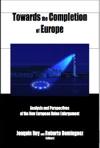
Towards the Completion of Europe: Analysis and Perspectives of the New European Union Enlargement.
Joaquín Roy and Roberto Domínguez (eds.). Miami: European Union Center/Jean Monnet Chair, 2006. 296 p.
ISBN 0-9638678-7-3; JN30 .T685 2006
Introduction: Bridges to the East: a Collective Effort for Enlargement. Joaquín Roy and Roberto Domínguez, 7-10; Analytical approaches: The Challenge of EU Enlargement, Joaquín Roy, 13-27; Enlargement and the Promotion of Liberal Norms in Eastern Europe, Frank Schimmelfennig, 29-38. Theoretical Debates, Nuray Ibryamova and Roberto Domínguez, 39-51; Citizens and Enlargement: Citizenship and Free Movement, Willem Maas, 55-65; European Identity and the Challenge of Enlargement, Markus Thiel, 67-76; Preparing for new minorities, Maria Ilcheva, 77-88; Immigration and Citizenship, David Abraham, 89-99; Current Debates and Regional Transformations: The Challenges of EU Integration: Iberian Lessons for Eastern Europe, Sebastián Royo, 103-113; How much diversity can the EU withstand?Ania Krok-Paszkowska, 115-123; The Eastern Enlargements of the EU: Why and How Far? Finn Laursen, 125-135; Impacts on External Policies and Institutions: Can the Fifth Enlargement weaken the EU's Development Cooperation? Francesc Granell, 139-149; The impact of Enlargement on the Euro-Med Partnership, Beverly Crawford, 151-170; The Impact of Enlargement on the External Relations of the EU, Roberto Domínguez, 171-182; The European Parliament and Eastern Enlargement, Gaye Gungor, 183-194; Economic and Social Transformations: In Search of the Social Europe: the Eastern Enlargement in Political Perspective, Christiane Lemke, 197-208; The political economy of Baltic States accession into the EU: the impact on the role of state, Ramunas Vilpisauskas, 209-220; Shifting Competitiveness, Evolving MNE Strategies and EU Enlargement: The Case of Hungary, Yusaf Akbar , 221-235; Environmental Consequences of Enlargement, Monika Böhm, 237-242; The Road Ahead: Turkey: Turkey's Membership Application: Implications for the EU, Neill Nugent, 245-266; The Process of Europeanization in Turkey, Atila Eralp, 267-275; The Role of Security in the European Union - Turkey Relationship, Nuray Ibryamova, 277-287;
Download book
A Historical Dictionary of the European Union.
Joaquín Roy and Aimee Kanner. Scarecrow Press / Rowman & Littlefiel, Lanham, Maryland, 2006. 260 p.
Available at University of Miami's Richter Library HERE
The European Union, over half a century old and still growing stronger, is already much more than a mere "organization," although just what it is remains debatable. What is beyond any doubt is that, with 25 member states (and more on the waiting list) and a population of 450 million people, it cannot be overlooked in world affairs nor can it be ignored by those living within its borders. Its competences reach far beyond the earlier fields of trade and politics and now increasingly embrace foreign affairs, human rights and law.
It is therefore indispensable for all concerned to know more about it, although this is not always so easy even for the experts and insiders. For outsiders - including most Europeans - there are more questions than answers. This handy guide, among other things, provides some of the answers in the form of an extensive chronology, a comprehensive bibliography, a list of acronyms, and especially an informative dictionary with entries on significant persons, institutions, events and activities.
This volume was written by Joaquin Roy and Aimee Kanner, two academics with considerable experience in explaining the European Union. Dr. Roy, who has written numerous books and articles on the EU, is Jean Monnet Professor of European Integration at the University of Miami. Dr. Kanner is assistant professor of political science at Florida Atlantic University.
"Today, the construction of Europe is one of the world's central political projects. But to understand it, people need useful and comprehensive tools. I warmly congratulate the authors of the Historical Dictionary of the European Union - a "must-have" for all reference collections."
Josep Borrell
President, European Parliament
"Students and scholars, as well as the staff of the EU institutions, will find this reference tool enriching and useful."
Javier Solana
High Representative of the Common Foreign and Security Policy
Secretary General of the Council of European Union
“We welcome this useful research tool that will contribute to the enrichment of the understanding of the European Union around the world".
José Manuel Barroso, President of the European Commission
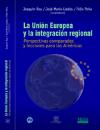
La Unión Europea y la integración regional: perspectivas comparadas y lecciones para las Américas.
Joaquín Roy, Félix Peña y José María Lladós (compiladores). Buenos Aires: Universidad Nacional de Tres de Febrero/ Consejo Argentino de Relaciones Internacionales, 2005.
Available at University of Miami's Richter Library HERE
Introducción, Joaquín Roy y Roberto Domínguez; América del Norte: NAFTA: Evaluación y Desarrollo Institucional, Roberto Domínguez; Norteamérica: tres naciones, asociación o comunidad?, Robert Pastor; Norteamérica: Comunidad o identidad?, Alejandro Chanona; El futuro de las relaciones económicas entre México y la UE:Es la UE un modelo para Norteamérica, Gustavo Vega Canovas; Relaciones México y Canadá con la UE: Objetivos comunes, estrategias encontradas,Stephan Sberro; América Central y el Caribe: El proyecto de Unión Aduanera Centroamericana: Más allá de la retórica, Fernando Rueda-Junquera; Las políticas del Acuerdo de Libre Comercio de Centroamérica (CAFTA), Eric Jacobstein; Un panorama de los acuerdos de gobernanza en CARICOM, Wendy Grenade; América del Sur: ¿Tiene Relevancia Global y Regional el Mercosur?, Félix Peña; Mercosur: Desarrollo politico y comparación con la UE, Marcos Aurelio Guedes de Oliveira; La Unión Europea y la Comunidad Andina, Aimee Kanner; La Comunidad Andina y el referente de la Unión Europea: Una visión temporal sobre la aplicación de los modelos de integración, Michel Levi-Coral; Integración Hemisférica: El Area de Libre Comercio de las Américas (ALCA): Su Peculiaridad desde una Perspectiva de la UE, Joaquín Roy; El Acuerdo de Libre Comercio de las Américas (ALCA), hoy, Jeffrey Schott; Meditaciones sobre el desarrollo y posibilidades de del ALCA: comparación con la UE, Ambler Moss; Los objetivos estratégicos del hemisferio: perspectiva europea, Karl Buck.
Revista Integracao e Comerco. INTAL, Buenos Aires. “O livro oferece algumas respostas tentativas a estas importantes perguntas, na compilação dos resultados de uma conferência internacional sobre o mesmo tema do livro, realizada em abril de 2005, na Universidade de Miami, com o apoio da Comissão Européia. Os capítulos do livro mostram que a integração nas sub-regiões das Américas exibe vários níveis de progresso, ao mesmo tempo em que descrevem as particulares circunstâncias que condicionam o desenvolvimento institucional dos processos, sua legitimidade e credibilidade.
The European Union and Regional Integration: a Comparative Perspective and Lessons for the Americas.
Joaquín Roy and Roberto Domínguez (eds.). Miami: European Union Center/Jean Monnet Chair, University of Miami, 2005. 314 pp.
ISBN 0-9638678-6-5; JZ5331 .E87 2005
Introduction, Joaquín Roy and Roberto Domínguez; North America: NAFTA: Assessments and Institutional Developmen, Roberto Domínguez; North America: Three Nations, a Partnership, or a Community?,Robert Pastor; North America Security: A Community or an Identity?,Alejandro Chanona; The future of Mexican-U.S. Economic Relations: Is the EU a Model for North America?,Gustavo Vega Cánovas; Comparing Canada, the European Union, and NAFTA:Comparative Carpers and Constitutional Conundrums,Steven B. Wolinetz; Central America and the Caribbean: Prospects for the Central American Customs Union,Fernando Rueda-Junquera; The Politics of the Central American Free Trade Agreement (CAFTA), Eric Jacobstein; The European Union and the Caribbean: the Case of Cub, Joaquín Roy; An overview of Regional Governance Arrangements within the Caribbean Community (CARICOM),Wendy Grenade; Internal Political Tribalism and Regional Integration in the Caribbean, David Hinds; South America: European Union External Relations with the Andean Community: A Governance Approach, Aimee Kanner; The Role of Networks in the European Union’s Foreign Policy toward Colombia,Roberto Domínguez; Understanding Mercosur and its Future, Félix Peña; Mercosur: Political Development and Comparative Issues with the European Union, Marcos Aurelio Guedes de Oliveira; Hemispheric Integration: The Uniqueness of the FTAA from an EU Perspective, Joaquín Roy; Reflections on the Development and Prospects of the FTAA: Does It Relate to the European Experience? Ambler H. Moss; The Free Trade Area of the Americas: Current Status and Prospects, Jeffrey Schott; Strategic Hemispheric Objectives for the Next Decade from a European Perspective, Karl Buck
Download book
La Unión Europea y el TLCAN: integración regional comparada y relaciones mútuas.
Joaquín Roy, Alejandro Chanona y Roberto Domínguez (compiladores). México: UNAM, 2004. 584 p.
Presentación: Joaquín Roy, Alejandro Chanona, Roberto Domínguez; Prólogos: Marte y Venus reconciliados:
Available at University of Miami's Richter Library HERE
Una nueva era en las relaciones transatlánticas, Javier Solana; El modelo de América del norte en un mundo de tres regions, Robert A. Pastor; ¿Es geografía destino? Rosario Green; 1. Teorías de la integración y regionalismo comparados: Teoría de la integración comparada: más allá de la dimensión económica, Finn Laurseen; Hacia la construcción de una perspectiva comparada: Unión Europea-TLCAN: Un acercamiento a la teoría liberal intergubernamentalista, Alejandro Chanona; Del spillover a la intergubernamentalidad: ¿Un nuevo paradigma de la integración en las Américas?, German A. de la Reza; La integración en Norteamérica y la experiencia de Europa, Leonardo Curzio; 2. La Unión Europea: tendencias generales: La naturaleza de la Unión Europea, Joaquín Roy; La Convención Europea, ¿Una Constitución para Europa?, Aimee Kanner; El futuro de la Unión Europea, Joaquín Roy; La política exterior de la Unión Europea, Roberto Domínguez Rivera; Los Balcanes diez años después: Macedonia, prueba de fuego y escaparate de la Política Exterior Común Europea, Stephan Sberro; La política monetaria del Banco Central Europeo y la ampliación de la Unión Europea, Jordi Bacaria Colom; 3. TLCAN: tendencias generales: TLCAN: ¿Es posible ir más allá del libre comercio?, Consuelo Dávila; México, Estados Unidos y el TLCAN después del 11 de septiembre: Posibles scenarios, Rafael Velázquez Flores; 4. Relaciones Interregionales: Canadá y la Unión Europea: Encuentros y desencuentros, Amy Verdun; Cooperación y confrontación en la relación Unión Europea-Estados Unidos, Roberto Domínguez; México y la Unión Europea: Algo más que un acuerdo de libre comercio, Marcela Szymanski; 5. América del Norte: la seguridad en la agenda regional: Seguridad en América del Norte entre el 11 de septiembre y la guerra de Irak: ¿Es posible la identidad regional en materia de defensa?, Alejandro Chanona; América del Norte: ¿Seguridad regional en construcción?, Raúl Benítez Manaus; Los nuevos referentes de la Seguridad Nacional en Estados Unidos, Juan Pablo Córdoba Elías; 6. Seguridad en el continente europeo: Tendencias de la seguridad europea, Emile J. Kirchner; La trascendencia de la seguridad europea, Roberto Peña Guerrero; 7. Percepciones y políticas del fenómeno migratorio: La Unión Europea y su política migratoria: Una historia de logros y obstáculos en el camino de su integración, María Asunción Merino Hernando; Cambio económico y migración: Una investigación comparativa de TLCAN y la Operación Bootstrap en Puerto Rico, James W. Russell; El TLCAN y el referente europeo: La movilidad laboral en la integración regional en Europa y en América del Norte, Mark Miller y Boyka Stefanova; 8. Economía e impactos sociales de la integración: Entre libre comercio y metas sociales: Integración regional en la Península Ibérica y México, Sebastián Royo; Más allá del libre comercio: Integración sin desarrollo en Mesoamérica y el Caribe, Víctor Godínez; La política comercial de Estados Unidos ante la integración de las Américas, Ricardo M. Buzo de la Peña

Retos e interrelaciones de la integración regional: Europa y América Latina.
Joaquín Roy, Roberto Domínguez and Rafael Velázquez (compiladores). México: Universidad de Quintana Roo/ Plaza y Valdés, 2003. 557 p.
Available at University of Miami's Richter Library HERE
Prólogos. América Latina, el Caribe y la Unión Europea: alianzas estratégicas, Enrique V. Iglesias; El camino de la Convención Europea, Valery Giscard d’Estaing; El lugar de Europa en el mundo, Javier Solana, ¿Qué tan nacional es el interés nacional?, Chris Patten. Parte I. La Unión Europea. Capítulo 1, La Unión Europea: de la arquitectura a la alquimia, Joaquín Roy; Capítulo 2, Teorías de la integración: ¿existe una perspectiva comparada entre la UE y el TLCAN?, Alejandro Chanona Burguete; Capítulo 3, Los ampliación de la Unión Europea hacia el este: negociando una oportunidad histórica, Nuray Ibryamova; Capítulo 4, Las relaciones comerciales internacionales de la Unión Europea, María Cristina Rosas; Capítulo 5, América Latina en la perspectiva de la Unión Europea: un panorama general, Roberto Domínguez Rivera; Capítulo 6, La Unión Europea ante Cuba y Colombia: de buenas intenciones y altas esperanzas a notables contradicciones y grandes frustraciones, Joaquín Roy; Parte II. Las Américas; América del Norte. Capítulo 7, NAFTA: estructura, operación y evaluación de su funcionamiento, Jerry Haar y Antonio Garrastazu; Capítulo 8, América del Norte y sus fronteras: el caso del Caribe, Rafael Velásquez Flores; Capítulo 9, La Unión Europea frente a la hegemonía estadounidense, Roberto Domínguez Rivera; América Central. Capítulo 10, La arquitectura de la integración de América Central, Dámaso Morales; Capítulo 11, Perspectivas de la integración centroamericana: ALCA, Caribe o TLCAN, Berenice P. Ramírez López; Capítulo 12, La Unión Europea y Centroamérica: examen a unas relaciones de baja intensidad, José Ángel Sotillo Lorenzo; El Caribe. Capítulo 13, Los esquemas de integración en el Caribe, Patsy Lewis; Capítulo 14, La cooperación en el Caribe: el caso de los energéticos, Juan Carlos Arriaga; Capítulo 15, La Unión Europea y el Caribe: análisis y retos, Luis Ritto; La comunidad andina. Capítulo 16, La Comunidad Andina de Naciones: Mercosur o ALCA, Elsa Cardozo de da Silva; Capítulo 17, La Unión Europea y la Comunidad Andina. Opciones para la política ante la crisis subregional, Christian Freres; Capítulo 18, Panorama de las relaciones entre la Unión Europea y la Comunidad Andina, Karina Pacheco Medrano; MERCOSUR. Capítulo 19, Mercosur: estructura y propósitos, Aimee Kanner; Capítulo 20, MERCOSUR: Análisis de una década y tendencias futuras, Félix Peña; Capítulo 21, Implicaciones de la ampliación de la Unión Europea en las relaciones euromercosureñas, Manuel Cienfuegos Mateo; El Área de Libre Comercio de las Américas. Capítulo 22, Estructura y propósitos, Eduardo Roldán Acosta; Capítulo 23, El Área de Libre Comercio de las Américas: avances, contenidos y problemas, Jaime Estay Reino; Capítulo 24, El ALCA, Estados Unidos y Europa, Francesc Granell.
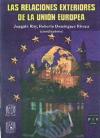
Las relaciones exteriores de la Unión Europea.
Joaquín Roy and Roberto Domínguez Rivera (compiladores) México: Universidad Nacional Autónona de México (UNAM), 2001. 355 p.
Available at University of Miami's Richter Library HERE
Primera parte. A manera de prólogo: tres visiones de las relaciones exteriores de la Unión Europea. “Europa y lo Universal”, Enrique Barón; “Una Política Exterior Común para Europa”, Chris Patten; “La Política Europea de Seguridad y Defensa: una Unión preparada para contribuir a la gestión de crisis y a la paz, Javier Solana; Segunda parte. Construcción y reforma de las relaciones exteriores de la Unión Europea. “El ‘modelo europeo’ en un mundo globalizado: una caracterización de la Unión Europea en el nuevo siglo”, Albert Galinsoga Jordà; “Ensalada de Niza: la reforma institucional”, Joaquín Roy; “Los retos del Euro frente a la escena internacional”, Francesc Granell, Las relaciones comerciales internacionales de la Unión Europea”, María Cristina Rosas; “El teléfono de Europa: la Política Exterior y de Seguridad Común (PESC)”, Joaquín Roy; Tercera parte. Entorno inmediato de las relaciones exteriores de la Unión Europea. “La primera ampliación de la Unión Europea en el siglo XXI. Los países de Europa central, República Checa, Polonia Hungría y Eslovenia”, Mariann Micsinai; “El sol sale en el oeste: esperanzas para integrase a la Unión Europea. Bulgaria, Rumania, los Países Bálticos y Eslovaquia, miembro Visegrado ‘tardío’”, Gabriela Marin Thornton; “Integrando la nueva periferia europea”, Nuray Ibryamova; “Relaciones entre la Unión Europea y los Países Terceros Mediterráneos”, Miquel Palomares Amat; “La Unión Europea y el proceso de paz de Oriente Medio”, Ignacio Álvarez-Ossorio; “La política de la Unión Europea hacia los países del Golfo Pérsico”, María de Lourdes Sierra Kobeh; Cuarta parte. Relaciones hacia el continente americano. “Redefiniciones y tendencias en la relación trasatlántica”, Roberto Domínguez Rivera; “Novedades y oportunidades de la relación de la UE con México”, Rafael Velázquez Flores; “Las relaciones de la Unión Europea con Centroamérica”, José Ángel Sotillo Lorenzo; “Cuba: un caso aparte en la política exterior de la Unión Europea”, Sussanne Gratius; “Europa y la integración andina: cooperación, diálogo político y relaciones económicas”, Jesper Tvevad; “Hacia la asociación Unión Europea-Mercosur: el largo camino hacia la liberalización comercial”, Andrew Crawley; Quinta parte. Replanteamiento de la relación con otras regiones. “Unión Europea y Asia Pacífico: nexos transcontinentales”, Carlos Uscanga; “La relación China-Unión Europea en el marco de la Organización Mundial de Comercio”, Juan González García; “Las relaciones entre la Unión Europea y los países ACP: de la política de Lomé al Acuerdo de Cotonou”, Núria Camps Mirabet.
Reviews: A.M. J. Política Exterior (Vol. XVI, Septiembre/Octubre 2002, No. 89, Madrid): “Coordinado por dos destacados especialistas en política internacional...respondiendo al interés y necesidad de un mejor conocimiento del proceso de construcción europea... lo que propicia una interesante línea de colaboración con la universidad española... el libro termina con un interesante anexo de estadísticas, organigramas y una caracterización de las instituciones comunitarias, junto con una breve y actualizada bibliografía, que responde a la intención docente del proyecto”.
The Ibero-American Space: Dimensions and Perceptions of the Special Relationship Between Spain and Latin America.
Joaquín Roy and Albert Galinsoga (editors). Miami: Iberian Studies Institute, University of Miami/ Lleida: "Jean Monnet" Chair for European Integration, University of Lleida, 1997. 286 p.
Available at Unviersity of Miami's Richter Library HERE
Content: Chapter 1. Introduction. Albert Galinsoga and Joaquín Roy; Part I. Overall View. Chapter 2. Juan Antonio March Pujol, "The Making of the Ibero-American Space". Chapter 3. Joaquín Roy, "The Nature of Spain's Relations with Latin America"; Chapter 4, Albert Galisonga Jordà and Nuria Camps Mirabet, "The Ibero-American Community of Nations: An International Law Perspective"; Part II. Global Evaluation and Perceptions. Chapter 5. Antonia Martínez, Ismael Crespo, and Ariel Jerez, "Between Europe and Ibero-America: The Political Discourse of the Spanish Government"; Chapter 6. Andrés Serbin, "Foreign Policy and Ethnocentric Perceptions"; Chapter 7. Jean Grugel, "A Special Relation in Democracy". Part III. Special Links. Chapter 8. Alfredo Arahuetes García and Julio Argüelles Alvarez, "Spanish Direct Investment in Latin America (1981-1992"; Chapter 9. JoAnn Fagot Aviel, "Spanish Aid Policies". Chapter 10. María Angels Miralpeix Gúell, “The Spanish government development aid to Central America”. Part IV: Cuba. Chapter 11. Joaquín Roy, "Spain and Cuba: a very special relationship"; Postscript. Bibliography
"Crucial to a correct understanding of both the historical connections and future prospects of the relationships between these two social, cultural and politicals speces... Roy provides us with a suggestive reflection on the general factors affecting the relationships between Spain and Latin America... and ambitious attempt to deal with the dynamics, components and prospects of the relationship... contributes to a better understanding of the situation of Latin America in the international world" (Manuel Alcántara, University of Salamanca, Journal of Latin American Studies, 1998).
El espacio iberoamericano: dimensiones y percepciones de la relación especial entre España y América Latina.
Joaquín Roy y Juan Antonio March (compiladores). Miami/Barcelona: Instituto de Estudios Ibéricos/ Centro de Estudios Internacionales, 1996. 250 p.
Content: Introducción; Juan Antonio March Pujol, "La construcción del espacio iberoamericano";Joaquín Roy, "La naturaleza de las relaciones de España con América Latina"; Albert Galisonga Jordà y Nuria Camps Mirabet, "La Comunidad Iberoamericana de naciones en la perspectiva del derecho internacional"; Antonia Martínez, Ismael Crespo y Ariel Jerez, "Entre Europa e Iberoamérica: El discurso político de los gobiernos españoles"; Andrés Serbín, "Más allá del Quinto Centenario: Política exterior y percepciones etnohistóricas en las relaciones entre América Latina y España"; Jean Grugel, "España y Latinoamérica: Una relación en la democracia"; Alfredo Arahuetes García y Julio Argüelles Alvarez, "Las inversiones directas de España en América Latina: 1981-1992"; JoAnn Fagot Aviel, "La política de cooperación de España"; Joaquín Roy, "España y Cuba: Una relación muy especial"; Joaquín Roy, "Posdata"; Bibliografía
The Reconstruction of Central America: the Role of the European Community.
Joaquín Roy, editor. Coral Gables, Fla.: Institute of Iberian Studies/European Community Project, University of Miami, 1991. 423 p.
Available at University of Miami's Richter Library HERE
Compilation of papers delivered at a conference held at the University of Miami under the sponsorship of the European Commission and the North-South Center. Participants: Gabriel Aguilera Peralta, John Booth, Victor Bulmer-Thomas, Fernando Cardesa, Ford Cooper, Ricardo Córdova Macías, Rafel de Juan, Cristina Eguizábal, JoAnn Fagot Aviel, Mark Falcoff, Albert Galinsoga, Roy Ginsberg, Wolf Grabendorff, René Herrera, Renato Iturriaga, Pierre-Henri Laurent, Abel Matutes, Rafael Monjívar, James Michel, Guillermo Molina Chocano, Ambler Moss, Mark Rosenberg, Mitchell Seligson, Angel Viñas, Marko Voljc, Laurence Whitehead.
Reviews: "Some of the articles are informative and interesting.. a very mixed bag, useful and thought provoking", International Affairs, April 1993.
References: The Process of San José: Ten Years Later. Brussels/Madrid: European Commission/ IRELA, 1995), p.141; Le processus de San José: Dix ans après. Brussels/Madrid: European Commission/ IRELA, 1995), p.141; Hazel Smith, European Union Foreign Policy and Central America. New York: MacMillan, 1995.
La reconstrucción de Centroamérica: el papel de la Comunidad Europea.
Joaquín Roy, compilador. Coral Gables, Fla.: Instituto de Estudios Ibéricos, University of Miami, 1991. 441 p.
Available at University of Miami's Richter Library HERE
Reviews: "Sin duda este libro enseñará algunos caminos para este objetivo [a pesar de que hayan desaparecido los motivos geopolíticos de los años ochentas] es muy positivo que se publicara tanto en inglés como en español, posibilitando una mayor difusión tanto en Europa como en las Américas... se destaca la presencia de un buen número de los mejores expertos", Dolores Romero, Síntesis (Madrid), No. 18, setiembre-diciembre 1992, pp. 225-227; "Esta compilación de ponencias es una referencia a tener en cuenta tanto por la diversidad de tópicos que son analizados como por lo novedoso de algunos de los enfoques allí utilizados. Sin duda, merece más que una lectura", Marcelo Lasagna, Revista CIDOB d'Afers Internacionals, No. 24;
References: El proceso de San José: Diez años después. Brussels/Madrid: European Commission/ IRELA, 1995), p.141.
Roy, Joaquín. Cuba, the United States and the Helms-Burton Doctrine: International Reactions Gainesville, FL: University Press of Florida, 2000.
http://www.upf.com/book.asp?id=ROYXXS00
http://books.google.com/books?id=MDBcA7zcGK0C&pg=PR11&lpg=PR11&dq=joaquin+roy+cuba&source=web&ots=-1wzBIDunB&sig=wtQ5no1fZ4-PH1K4Mjld5x9ZBC8#PPA37,M1
Awards and Nominations:
·Selected as the Book of the Month by Política Exterior (September 2000)
·Selected by the American Academy of Diplomacy for 2000 Book Nominations
Reviews: Kenneth Maxwell, Foreign Affairs, Vol. 79, No. 5 (September/October 2000), pp.143-144: “A useful analysis of the 1966 Helms-Burton Act that examines both its origins and its international repercussions”.
http://www-dev.foreignaffairs.org/20000901fabook892/joaquin-roy/cuba-the-united-states-and-the-helms-burton-doctrine-international-reactions.html
Philip Chrimes, International Affairs (London), Vol. 77, No. 3, July 2001, pp. 759-760.
Joaquín Roy presents the most rounded analysis of Helms-Burton to date… Roy is the most incise when setting out the legal case against the many unprecedented aspects of the Helms-Burton bill, striking just the right balance between complex legal argumentation and accessibility for the general reader .. overall, this book constitutes an excellent primer for those who need to come to grips with this disturbing and ill-conceived piece of legislation.”
Jorge Domínguez, Journal of Latin American Studies (London), Vol, 33, November 2001, pp. 888-890.
Joaquín Roy has written a comprehensive, informative and thoughtful narrative about the Helms-Burton Act, its origins, its consequences and the politics that surrounded all of these aspects. Among the most valuable aspects of this book is its detailed explication and assessment of the various chapters of the law. Roy reviews systematically and fairly the political science, legal and policy scholarship regarding Helms-Burton to complement his own. Notwithstanding his own critical stance toward Helms-Burton, Roy’s capacity to describe the arguments of the Act’s supporters in terms that they would recognise its arguments is admirable.
Kenneth J. Grieb, Hispanic American Historical Review 82.1 (2002) 204-205.
Providing a detailed account of the domestic political context of the bill, the author effectively traces its origins in both the Cuban exile community and the national political scene, while summarizing the subsequent debate…The strength of the study is that it effectively summarizes in a single volume the comments of political pundits and scholars in diverse fields spanning several countries, thereby providing easy access to the studies from different fields, particularly linking historical and political studies to legal analyzes. It draws on works that provide context for both U.S.-Cuban relations and the politics of the Cuban exile community in Florida and their impact on the national political scene…This study will be of interest to all students of Cuba and U.S.-Latin American policy, as well as those concerned with the political influence of the Cuban exile community. Its primary value is its breath, concisely summarizing previously published works spanning the literature of several different field.
http://muse.jhu.edu/journals/hispanic_american_historical_review/v082/82.1grieb.html



 A New Atlantic Community
A New Atlantic Community
 The Transatlantic Trade and Investment Partnership between the European Union and the United States
The Transatlantic Trade and Investment Partnership between the European Union and the United States
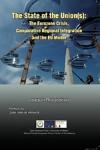

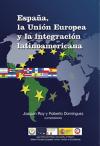
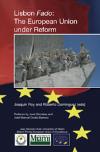
 The Cuban Revolution (1959-2009): its relationship with Spain, the European Union and the United States.
The Cuban Revolution (1959-2009): its relationship with Spain, the European Union and the United States.